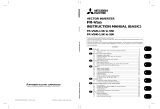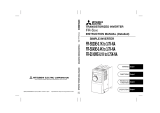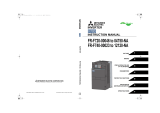Page is loading ...

Printed in Japan
IB(N A)-0600044-A(0007)M EE
Specifications subject to change w ithout notice.
TRANSISTORIZED INVERTER
INSTRUCTION M ANUAL
HEAD OFFICE:MITSUBISHI DENKI BLDG M ARUNOUCHI TOKYO 100-8310
FR -FH
R A TIO SETTER

A-1
Thank you for choosing this Mitsubishi transistorized Inverter option.
This instruction manual gives handling information and precautions for use of this
equipment.
Incorrect handling might cause an unexpected fault. Before using the equipment,
please read this manual carefully to use the equipment to its optimum.
Please forward this manual to the end user.
This section is specifically about safety matters
Do not attempt to install, operate, maintain or inspect this product until you have
read through this instruction manual and appended documents carefully and can
use the equipment correctly.
Do not use this product until you have a full knowledge of the equipment, safety
information and instructions.
In this instruction manual, the safety instruction levels are classified into
“WARNING” and “CAUTION”.
WARNING
Assumes that incorrect handling may cause hazardous
conditions, resulting in death or severe injury.
CAUTION
Assumes that incorrect handling may cause hazardous
conditions, resulting in medium or slight injury, or may
cause physical damage only.
Note that the CAUTION level may lead to a serious consequence according to
conditions. Please follow the instructions of both levels because they are important
to personnel safety.

A-2
SAFETY INSTRUCTIONS
1. Electric Shock Prevention
WARNING
While power is on or when the inverter is running, do not open the front cover.
You may get an electric shock.
Do not run the inverter with the front cover removed. Otherwise, you may access
the exposed high-voltage terminals or the charging part of the circuitry and get
an electric shock.
If power is off, do not remove the front cover except for wiring or periodic
inspection. You may access the charged inverter circuits and get an electric
shock.
Before starting wiring or inspection, switch power off, wait for more at least 10
minutes and check for the presence of any residual voltage with a meter etc.
Earth the option unit.
Any person who is involved in the wiring or inspection of this equipment should
be fully competent to do the work.
Always install the inverter before wiring. Otherwise, you may get an electric
shock or be injured.
Operate the switches with dry hands to prevent an electric shock.
Do not subject the cables to scratches, excessive stress, heavy loads or
pinching. Otherwise, you may get an electric shock.
2. Fire Prevention
CAUTION
Mount the option unit on an incombustible surface. Installing the inverter or
option unit directly on or near a combustible surface could lead to a fire.
If the inverter has become faulty, switch off the inverter power. A continuous flow
of large current could cause a fire.
3. Injury Prevention
CAUTION
Apply only the voltage specified in the instruction manual to each terminal to
prevent damage etc.
Ensure that the cables are connected to the correct terminals. Otherwise,
damage etc. may occur.
Always make sure that polarity is correct to prevent damage etc.
While power is on and for some time after power-off, do not touch the option unit
as they are hot and you may get burnt.

A-3
4. Additional instructions
Also note the following points to prevent an accidental failure, injury, electric shock, etc.:
(1) Transportation and installation
CAUTION
When carrying products, use correct lifting gear to prevent injury.
Do not stack the inverter boxes higher than the number recommended.
Ensure that installation position and material can withstand the weight of the
option unit. Install according to the information in the Instruction Manual.
Do not operate if the option unit is damaged or has parts missing.
Do not stand or rest heavy objects on the option unit.
Check the option unit mounting orientation is correct.
Prevent screws, wire fragments, conductive bodies, oil or other flammable
substances from entering the option unit.
Do not drop the option unit, or subject it to impact.
Use the inverter under the following environmental conditions:
Ambient
temperature
-10°C to +50°C (non-freezing)
Ambient humidity 90%RH or less (non-condensing)
Storage
temperature
-20°C to +65°C*
Ambience
Indoors (free from corrosive gas, flammable gas,
oil mist, dust and dirt)
Environment
Altitude, vibration
Maximum 1000m above sea level for standard
operation.
5.9 m/s
2
or less (conforming to JIS C0911)
*Temperatures applicable for a short time, e.g. in transit.
(2) Trial run
CAUTION
Check all parameters, and ensure that the machine will not be damaged by a
sudden start-up.
(3) Operation
CAUTION
Do not modify the equipment.

A-4
(4) Emergency stop
CAUTION
Provide a safety backup such as an emergency brake which will prevent the
machine and equipment from hazardous conditions if the inverter or option unit
fails.
(5) Maintenance, inspection and parts replacement
CAUTION
Do not carry out a megger (insulation resistance) test on the control circuit of the
option unit.
(6) Disposing of the inverter
CAUTION
Treat as industrial waste.
(7) General instructions
Many of the diagrams and drawings in this instruction manual show the inverter
without a cover, or partially open. Never run the inverter like this. Always replace
the cover and follow this instruction manual when operating the inverter.

CONTENTS
1. STRUCTURE...........................................................................1
2. INSTALLATION.......................................................................2
3. WIRING ................................................................................... 2
4. CIRCUIT STRUCTURE........................................................... 3
5. CIRCUIT EXPLANATION........................................................ 4
6. ADJUSTMENT ........................................................................4
7. OPERATING INSTRUCTIONS................................................ 7
8. SPECIFICATIONS...................................................................7
9. OUTLINE DRAWING............................................................... 8
10. APPLICATION EXAMPLE ....................................................9

1
FR-FH RATIO SETTER
Incorporating five ratio setter circuits, a single FR-FH ratio setter can operate up to
five inverters at different ratios.
1. STRUCTURE
Power lamp (POWER)
Ratio/bias adjustment 1
(RATIO/BIAS 1)
Name plate
Fig. 1 Structure
Terminal block mounting screw
By loosening the screws at both ends, the terminal block comes u
p
toward you. Pull the terminal block to remove it from the inverter.
Ratio/bias adjustment 2
(RATIO/BIAS 2)
Ratio/bias adjustment 3
(RATIO/BIAS 3)
Ratio/bias adjustment 4
(RATIO/BIAS 4)
Ratio/bias adjustment 5
(RATIO/BIAS 5)
T
erminal cover
(removable)
FR-FH
POWER

2
2
.
INSTALLATION
(1) Avoid direct sunlight, high temperature, high humidity, much dust and much gas,
and select a clean, dry place to install. (The unit is not a totally enclosed type.)
(2) Select a place of installation where heat will not build up, and install the unit with
the minimal wiring distance from the inverter (e.g. install the unit within the control
box where the inverter is installed).
(3) When wiring, take the wiring space of the cables into consideration as the cables
will come out on the left side.
3. WIRING
(1) Remove the terminal cover. The terminal cover
comes off by pulling the left-hand side recesses
toward you as shown in Fig. 2.
(2) You can use a power supply of either single-
phase 200V or 115V. When using a 200V power
supply, wire it across terminals 200V-0. When
using a 115V power supply, wire it across
terminals 115V-0. Note that wrong wiring may
burn the internal transformer. (Refer to Fig. 3
Wiring Diagram.)
(3) When relay contacts are required in the signal
line, connect two micro-current switching relay
contacts in parallel (or a twin contact) to prevent
a contact fault.
(4) Use twisted or shielded cables as signal cables
and run them away from the power cables.
Panel for installation
Terminal cover
Fig. 2

3
4. CIRCUIT STRUCTURE
2
32
5
15
IM
U
V
W
OCR
NFB
R
T
S
AC200V 50Hz
12
200/220V 60Hz
SD
(STR)
STF
200V
115V
FR-FH
[RATIO 1]
[RATIO 2]
[RATIO 3]
[RATIO 4]
[RATIO 5]
[BIAS 1]
[BIAS 2]
[BIAS 4]
[BIAS 5]
[BIAS 3]
35
10
22
25
42
45
52
55
A2
A5
A10
(+10V)
1K
2W
R
T
S
T
200V
0
FR-FH
200
400
Power supply
Inverter
Motor
Automatic voltage
regulator circuit
Frequency setting
potentiometer
Ratio setting
Bias setting
Wiring for use with
400V class inverter
Inverter
Fig. 3 Circuit Structure and Wiring Example

4
5. CIRCUIT EXPLANATION
The ratio setter has five ratio setter circuits consisting of operational amplifiers as
shown in Fig. 3. Each circuit is provided with the ratio setting potentiometer (RATIO)
and bias setting potentiometer (BIAS) which enable independent setting.
The relationships (gains) between the input and outputs of each circuit are as follows.
Note that this applies to the bias of 0.
Input Signal (across Terminals A2-A5)
*Output Signal
(across Terminals 12-15 to 52-55)
5VDC Adjustable in the range 0 to 10VDC
10VDC Adjustable in the range 0 to 10VDC
*Input of a negative voltage outputs a negative voltage. (Refer to page 5)
Bias setting allows 10VDC to be increased or decreased to or from the output,
independently of the ratio setter. (Refer to page 6)
6. ADJUSTMENT
When the input voltage to the ratio setter is varied in the range 0 to 100% (0 to 5V or 0
to 10V) with the frequency setting potentiometer (1K 2WΩ variable resistor), its output
characteristic is adjustable within the ranges shown in Figs. 4, 5 and 6. The I/O
characteristics, which are described in the typical circuit, can be adjusted in the same
procedure for all the five circuits.

5
(1) Ratio setting (RATIO):
::
: Changing the slope of the characteristic
After the input voltage (across terminals A2-A5) has been set to 0V with the
frequency setting potentiometer and the voltage across frequency terminals 12-15
adjusted to 0V with the bias setting potentiometer (BIAS), any of the
characteristics (within the diagonally shaded area) shown in Fig. 4 can be
obtained according to the setting position (input) of the frequency setting
potentiometer. This indicates that the setting of "RATIO" provides the slope of 0 to
100%.
When the slope you need is other than the standard setting, adjusting the "RATIO"
potentiometer enables the frequency setting output signal (across terminals 12-
15) to be 5V at the input voltage (across terminals A2-A5) of 10V.
10
-10
0
5
10
-10
5
-5
-5
(V)
(V)
Maximum setting
Slope 200%
Standard setting
Slope 100%
(Factory setting)
Output (across 12-15)
Input (across A2-A5)
Fig. 4 "RATIO" Setting (at Bias of 0)
Slope 50%
Slope 0%

6
(2) Bias setting (BIAS):
::
: Translating the characteristic vertically
With the "RATIO" potentiometer in the standard setting position as shown in (1),
turning the "BIAS" potentiometer translates the output characteristic vertically as
shown in Fig. 5 and 6. This bias adjustment can be made within the range +10V to
-10V. A clockwise turn of the "RATIO" potentiometer decreases the output voltage
and a clockwise turn increases.
10
-10
0
5
10
-10
5
-5
-5
(V)
(V)
(V)
(V)
Bias setting range
Output
V
R maximum
VR middle
Input
VR minimum
Fig. 5 "BIAS" Setting
(At Standard Setting of "RATIO")
(V
)
10
-10
0
5
10
-10
5
-5
(V)
(V)
(V)
Bias setting range
Output
Input
Fig. 6 "BIAS" Setting
(At Maximum Setting of "RATIO")
Standard setting
(Factory setting)

7
7. OPERATING INSTRUCTIONS
(1) If you make the bias setting onto the negative side or enter a negative voltage to
the input terminal, full attention should be paid to the connected equipment since
the frequency setting signal (output) will be a negative voltage.
(2) When connecting a variable resistor to the main speed setting input, use the one of
a rating of 1KΩ to 2KΩ at 1W or more.
8. SPECIFICATIONS
Power supply voltage 200VAC 50Hz, 200/220VAC 60Hz
115VAC 60Hz
Power consumption 3VA
Frequency setting input signal
[Terminal A2]
0 to 10VDC, 0 to 5VDC
input resistance 10KΩ
Frequency setting power supply
[Terminal A10]
10VDC, 10mA permissible load current
Number of ratio setting circuits 5 circuits
Frequency setting output signal Adjustable in the range 0 to ±10VDC (5mA)
per circuit
Adjustment functions RATIO setting (range 0 to 200%) ... Refer to
page 5
BIAS setting (range 0 to ±10VDC) ... Refer to
page 6

8
9. OUTLINE DRAWING
101
5
5
36
14
50
NAME
PLATE
185
192
3.5
3.5
Terminal cover (removable)
FR-FH
POWER
RATIO BIAS

9
10. APPLICATION EXAMPLE
(1) Running 5 inverters
1K
A10
A2
A5
2W
FR-FH
12.15
22.25
42.45
52.55
32.35
Ratio setter
Frequency setting
potentiometer
No. 1 Inverter
No. 2 Inverter
No. 3 Inverter
No. 4 Inverter
No. 5 Inverter
*You can connect
up to five inverters
to one ratio setter.
(2) Running 7 inverters
No.2
No.3
No.4
No.5
1K
2W
A10
A2
A5
FR-FH
12.15
22.25
42.45
32.35
A10
A2
A5
FR-FH
12.15
22.25
42.45
32.35
52.55
52.55
No.1
No.6
No.7
Ratio setter
Frequency setting
potentiometer
Inverter
*When connecting
more than five
inverters, use two
or more ratio
setters.
Two FR-FH units
allows connection
of up to nine
inverters.
Maximum number
of inverters that
may be connected
using "n" FR-FH
units
4n+1 [units]

REVISIONS
*The manual number is given on the bottom left of the back cover.
Print Date *Manual Number Revision
Jul., 2000 IB(NA)-0600044-A First edition
/


